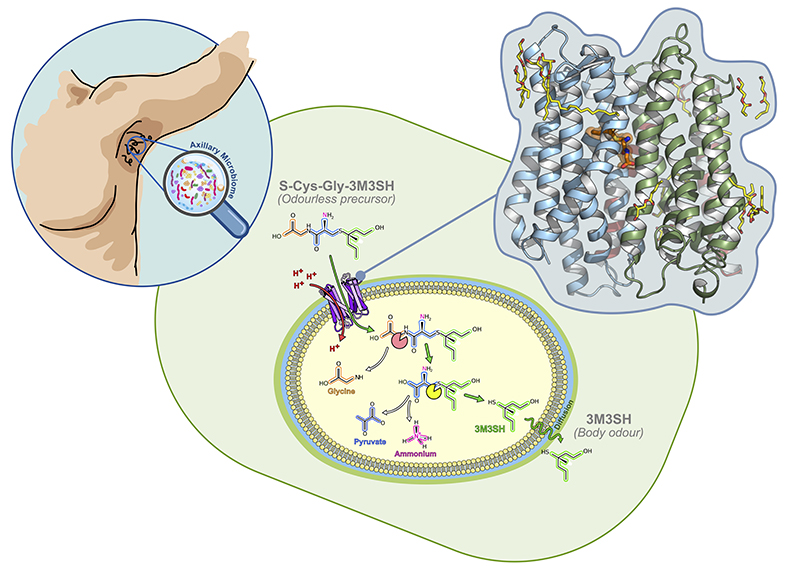- Home
- News
- General News
- Scientists unravel...
Scientists unravel mechanism for body odour in armpits
01-08-2018
British researchers from the University of York and the University of Oxford have shown the mechanism that leads to body odour in armpits by studying the molecular process at the ESRF and other lightsources. This could lead to more effective and targeted deodorants.
Stepping into a cramped bus on a hot summer day can sometimes translate into having to hold your breath and a very unpleasant experience. Sweat production increases in hot weather, and, with it, body odour. Despite much research and antiperspirant deodorants, scientists still haven’t managed to selectively block body odour.
Researchers from the University of York and the University of Oxford have recently used the ESRF and Diamond Lightsource to find out what happens at a molecular level when we smell badly. They focused on the apocrine gland, which is found only in the armpit, genitalia and ear canal. It secrets an odourless lipid-rich viscous secretion, which is likely to play a role in scent generation, but it is not involved in thermoregulation.
It all comes down to bacteria. “The skin of our underarms provides a unique niche for bacteria,” explains investigator Gavin Thomas, professor in the department of biology at the University of York and co-leader of the study. “Through the secretions of various glands that open onto the skin or into hair follicles, this environment is nutrient-rich and hosts its own microbial community, the armpit microbiome, of many species of different microbes.”
 |
|
Picture showing how body odour is produced in armpits. Credits: University of York and Oxford. |
The first time the link was made between the apocrine gland, underarm bacteria and body odour was over 50 years ago. Since then, various molecules in the axilla have been associated with malodour. The British team focused on a particularly pungent component of these chemicals, called thioalcohols or sulfanylalkanos. 3-methyl-3-sulfanylhexan-1-ol (3M3SH) is a major determinant of body odour and is made by the skin bacteria following uptake of the non-smelly precursor molecule, S-Cys-Gly-3M3SH, which is secreted in the armpit during the day. Scientists were, until now, baffled as to how the bacteria recognise the molecule and produce body odour.
The team successfully identified how the initially non-smelly precursor molecule is recognised and transported into the bacteria on our skin; through the action of a specific membrane transporter, PepTSh.
To determine the molecular structure of the transport protein responsible for the uptake of S-Cys-Gly-3M3SH into the bacteria, they teamed up with Professor Simon Newstead in the department of biochemistry at the University of Oxford. His group, led by Dr Gurdeep Minhas, came to the ESRF’s ID23-2 beamline, where they carried out experiments that allowed them to identify and decode the structure of the transport protein in the process of moving the chemical component across the membrane. This is important because this transport is necessary for body odour formation.
From targeted deodorants to medical applications
Antiperspirant deodorants today are very efficient at controlling the bacteria in our underarms. However, this research shows that there is only a very small number of bacteria in armpits responsible for bad smell. “We could envisage developing strategies that aim to reduce the function of this transport protein in bacteria and, with it, block the production of body odour”, say the team.
The potential benefits of this research go beyond improvements in cosmetics and personal hygiene products. Co-lead Newstead says: “The protein is a member of a family of peptide transporters present in many bacteria and also in our bodies, where it is responsible for the uptake of amino acid conjugated drug molecules. The new insights presented in this study may therefore also provide clues as to how this family of transporters bind other diverse peptides and drug molecules.”
Text by Montserrat Capellas Espuny
Reference:
Minhas, GS, et al, eLife 2018;7:e34995 DOI: 10.7554/eLife.34995
Top image: Crystal structure of PepTSh shown in the plane of the membrane. This membrane transporter takes the non-smelly precursor molecule into the bacteria on our skin. Credits: University of York and University of Oxford.



